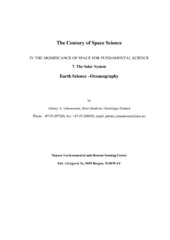Earth science – oceanography
Chapter
Permanent lenke
https://hdl.handle.net/1956/1120Utgivelsesdato
2002Metadata
Vis full innførselSamlinger
Sammendrag
Satellite oceanography began with the Gemini XII flight in November 1966. From a Hasselblad camera mounted in the pilot’s window large internal waves in the eastern tropical Atlantic were photographed via sunglitter for the first time. The ability to observe and analyze the ocean surface from space has, since then, improved significantly thanks to the instrument technology development combined with advances in high performance computing and numerical simulation. Today Earth observing satellites provide global, quasi-synoptic, repetitive and homogeneous observations of a large number of geophysical and bio-chemical variables and processes at the ocean surface. Included among these are sea ice extent and concentration, sea surface temperature, sea level and ocean circulation, sea state and algae bloom. These observations are highly complementary to those data collected by in-situ sensors and form an essential element in the global ocean observing system. In this article, the status of satellite oceanography at the onset of the new millennium is assessed in the context of two categories, namely climate research and monitoring and operational oceanography. Looking ahead, the challenge and need to explore new Earth Observation capabilities aimed at bringing new data and scientific understanding is then discussed and recognized in light of the importance and demand to ensure continuity of existing satellite oceanography.
Beskrivelse
In: The century of space science. Bleeker, J.A.; Geiss, J.; Huber, M. (Eds.) Pp. 1585-1622
